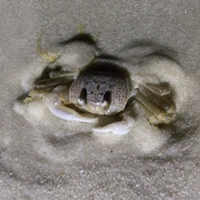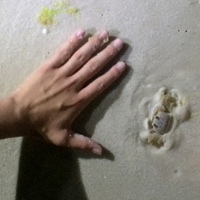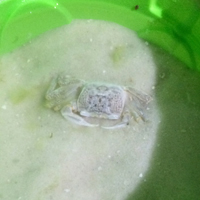Caution: Ghost Crab hunting tends to create smiles, laughter, squealing, giggling and may cause permanent vacation memories of your trip to the Emerald Coast.
 When the sun goes down the Ghost Crabs come out on Navarre Beach. Don't be alarmed; these guys are small, relatively harmless and very much afraid of you. Ghost Crabs get their name from the fact that they come out at night and are white. They are also called sand crabs since they are the same color and blend into the sand in which they live.
When the sun goes down the Ghost Crabs come out on Navarre Beach. Don't be alarmed; these guys are small, relatively harmless and very much afraid of you. Ghost Crabs get their name from the fact that they come out at night and are white. They are also called sand crabs since they are the same color and blend into the sand in which they live.
We have seen and caught small Ghost Crabs smaller than a dime and as large as several inches across. You can't miss seeing the larger ones with their menacing beady eyes that fixate on you. They tend to hang out next to the edge of the surf along the top edge of the sandy berms created where the waves crash along the beach. You can also find some larger ones near the base of the beach dune. However, the beach dune is off limits to humans and should be considered home base for the crabs.
 Ghost Crabs are only active in the warmer months and hibernate in the cooler months. The hunting is more finding and chasing than catching. These guys have great eyesight and will see you way before you see them. And with eight legs, they move much faster across the sand than you. The bigger ones will dash into the surf and the small ones will find their burrows in the sand with great speed.
Ghost Crabs are only active in the warmer months and hibernate in the cooler months. The hunting is more finding and chasing than catching. These guys have great eyesight and will see you way before you see them. And with eight legs, they move much faster across the sand than you. The bigger ones will dash into the surf and the small ones will find their burrows in the sand with great speed.
If you are up for a fun filled after dark challenge on the beach, you'll need a bit of low tech hunting gear and a hunting party. Grab a flashlight, sand bucket, hand-held net, and your adventurous posse of crab hunters and hit the beach. We find that teams work best to be able to corral and catch the speedy little crustaceans. Once you get one surrounded away from the surf you will have a fighting chance of capturing a Ghost Crab. The larger ones will tend to cover themselves in the sand to hide, but the smaller ones will keep attempting escape by running away. With a little trial and error, you and your hunting party will develop a strategy for successful wrangling.
 The best way to capture a smaller Ghost Crab is to cup it between two hands. The larger ones can be picked up from behind by pinching the back of their body between your thumb and forefinger. They tend not to attempt to pinch unless they are getting pinched or squished too hard themselves. Even then, it doesn't really hurt. You may want to take a bit more caution with the larger ones, however there is more danger for the crab than you. For the less courageous hunters, a handheld net my be used, but these little guys tend to get out of the net unless you quickly get them in the bucket or grab them with your hands. Warning - don't be surprised if a larger crab is able to scale out of a small bucket.
The best way to capture a smaller Ghost Crab is to cup it between two hands. The larger ones can be picked up from behind by pinching the back of their body between your thumb and forefinger. They tend not to attempt to pinch unless they are getting pinched or squished too hard themselves. Even then, it doesn't really hurt. You may want to take a bit more caution with the larger ones, however there is more danger for the crab than you. For the less courageous hunters, a handheld net my be used, but these little guys tend to get out of the net unless you quickly get them in the bucket or grab them with your hands. Warning - don't be surprised if a larger crab is able to scale out of a small bucket.
Please be gentle on the crabs and free them quickly so they can get back to their hunt for food and remoisten their gills to keep breathing.